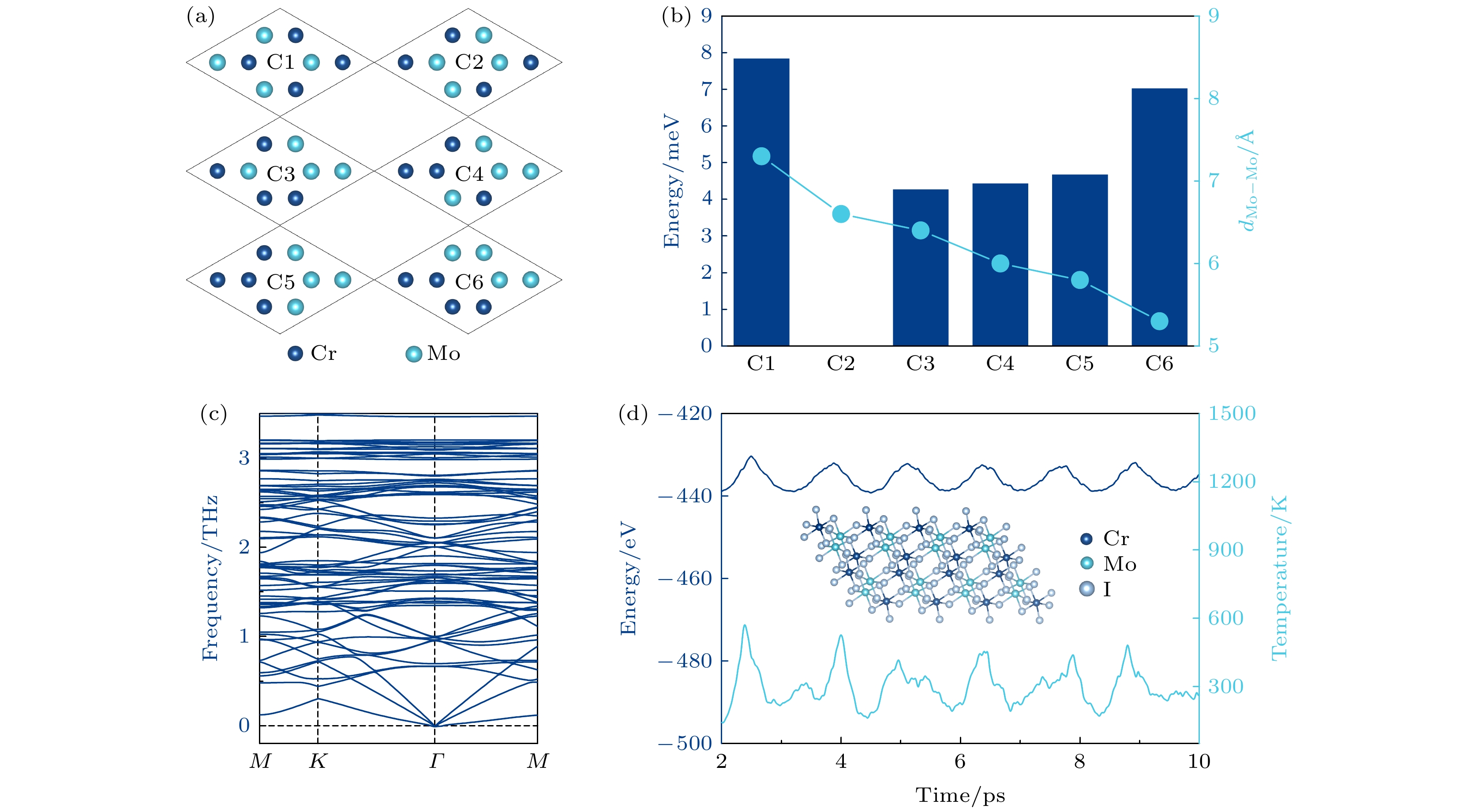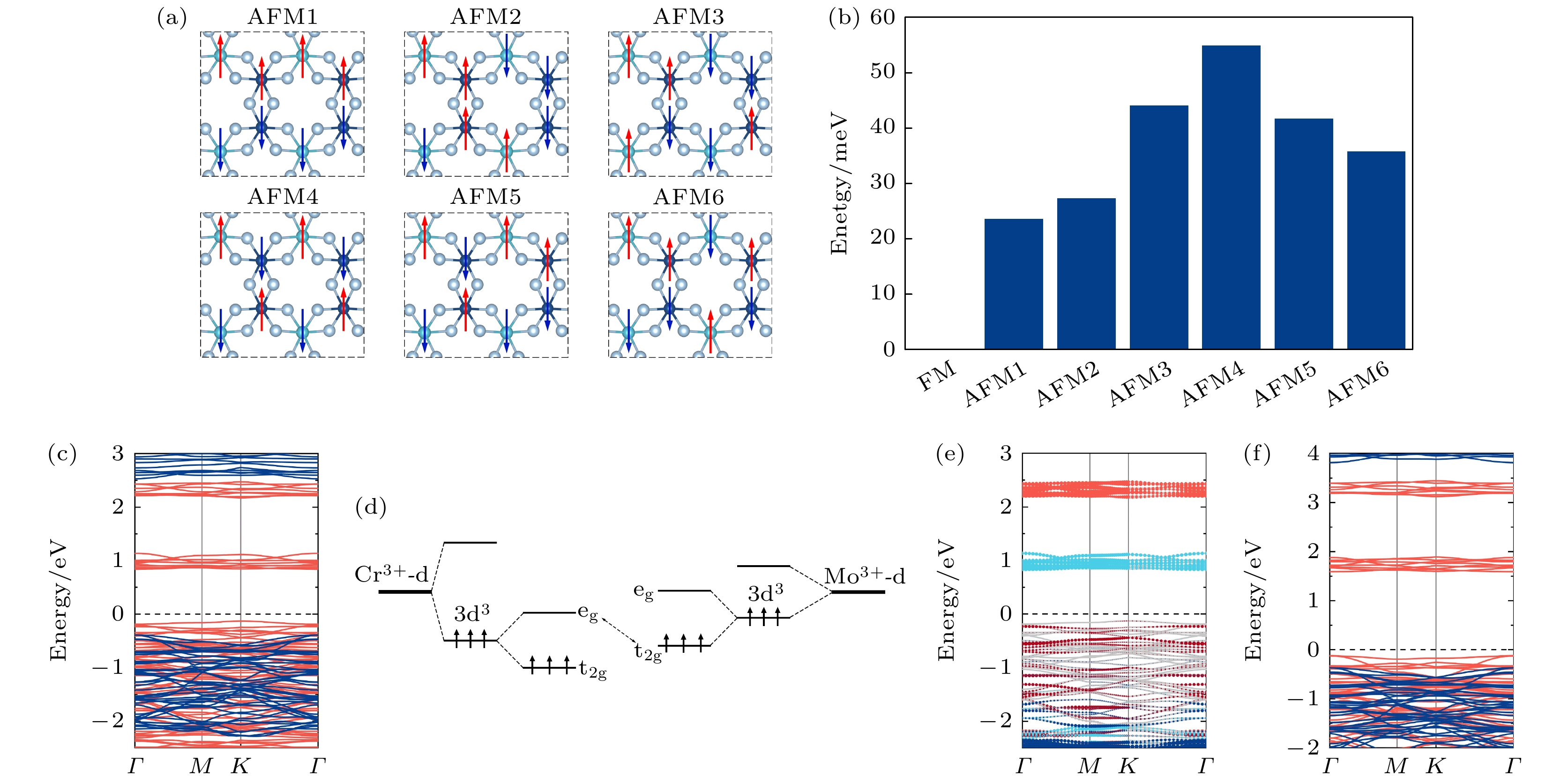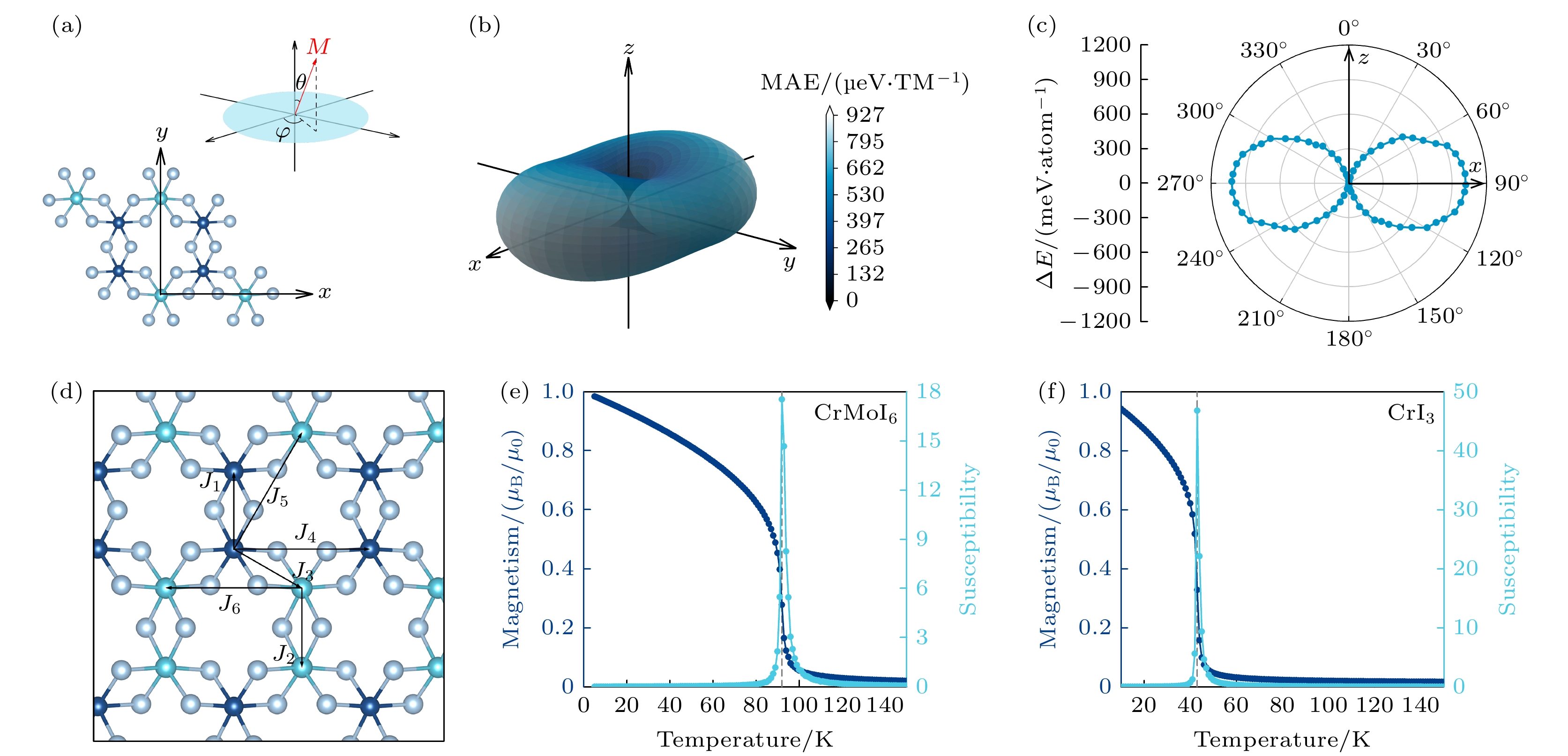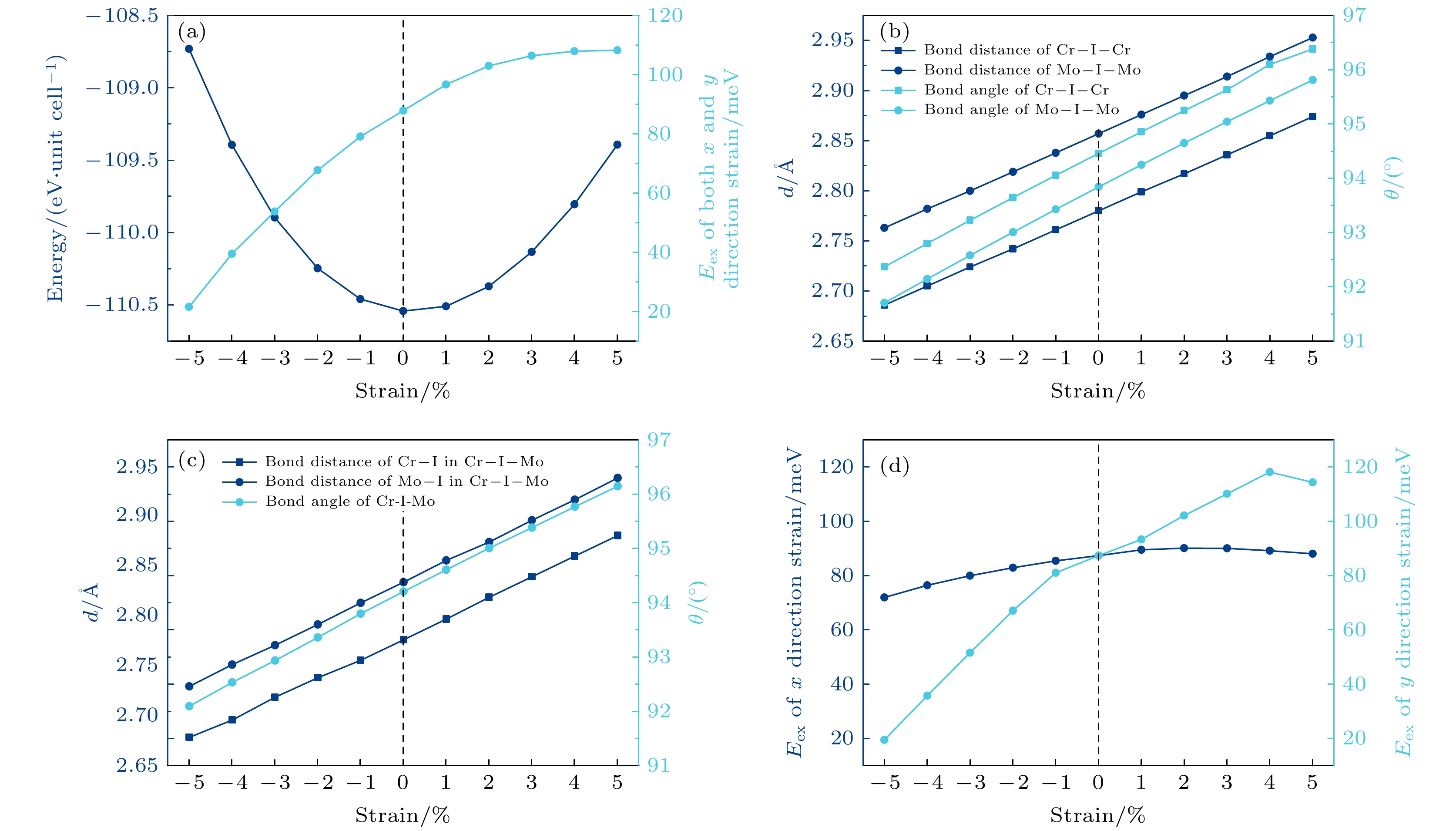-
二维磁性半导体由于兼具磁性、半导体性和特殊的二维结构而受到人们的广泛关注, 为纳米级自旋电子和光电子器件的研发应用和相关的基础理论研究提供了新的思路和平台. 基于第一性原理计算, 在对一系列二维双金属碘化物CrTMI6的交换能进行初步筛选的基础上, 选出了具有铁磁性的CrMoI6单层结构. 进一步计算表明, CrMoI6单层的电子能带结构展示出理想的半导体特性, 计算得到的带隙约为1.7 eV, 而且还具有很大的磁各向异性能(741.3 μeV/TM). 通过基于海森伯模型的蒙特卡罗模拟预测这一材料的居里温度达到92 K, 约为CrI3单层的2倍. 此外, 分子动力学和声子谱的计算还证明了其良好的热稳定性和动力学稳定性. 这类可以通过合金化方法合成的磁性过渡金属卤化物将进一步拓展二维磁性材料家族及其在自旋电子学器件领域的应用.Two-dimensional magnetic semiconductors have received extensive attention due to their combination of magnetism, semi-conductivity and special two-dimensional structures, which also provide a new idea and platform for developing the nanometer spintronic and optoelectronic devices and also for conducting the related basic theoretical research. However, in addition to the common problems of two-dimensional magnetic semiconductor materials, such as volume manufacturing and environmental stability, the two-dimensional magnetic semiconductor materials have the unique difficulty, i.e. low Curie temperature, which makes it difficult to maintain ferromagnetic coupling at higher temperature. For example, the Curie temperature of the existing CrI3 monolayer is lower than 45 K, while that of the Cr2Ge2Te6 double-layer is only 20 K, which is far lower than the room temperature. Therefore, how to improve the Curie temperature of two-dimensional magnetic semiconductor materials through various approaches is one of the important issues that need to be resolved in this field of research. Based on the first-principles calculations, the exchange energies of a series of two-dimensional bimetallic iodides CrTMI6 (TM denotes transition metal elements in fourth and fifth rows) constructed from the lattice of CrI3 monolayer are preliminarily calculated and screened. Structures are fully relaxed until the force and the energy are converged to 0.01 eV/Å and 10–6 eV, respectively, and the ferromagnetic CrMoI6 monolayer is selected. Further calculations show that the band structure of the CrMoI6 monolayer exhibits ideal semiconductor characteristics with a band gap of about 1.7 eV. At the same time, theoretical calculations with considering the spin-orbit coupling show that the CrMoI6 monolayer has a considerable magnetic anisotropy (741.3 μeV/TM), and its easy axis is perpendicular to the two-dimensional plane. Monte Carlo simulation based on the Heisenberg model predicts that the Curie temperature of CrMoI6 monolayer reaches 92 K, which is about twice that of the CrI3 monolayer. The molecular dynamics and phonon spectrum calculations also prove that it has both thermal and kinetic stability. In addition, under the condition of applying compressive and tensile strain, its ferromagnetic coupling shows strong stability. This kind of magnetic transition metal halide which can be synthesized by alloying will further expand the family of two-dimensional magnetic materials and their applications in the field of spintronic devices.
-
Keywords:
- two-dimensional materials /
- magnetic semiconductors /
- Curie temperature /
- magnetic anisotropy
[1] Novoselov K S, Mishchenko A, Carvalho A, Castro Neto A H 2016 Science 353 aac9439
 Google Scholar
Google Scholar
[2] Wang C, Xia K, Wang H, Liang X, Yin Z, Zhang Y 2019 Adv. Mater. 31 1801072
 Google Scholar
Google Scholar
[3] Gao Q, Zhang W, Shi Z, Yang L, Tang Y 2019 Adv. Mater. 31 1802880
 Google Scholar
Google Scholar
[4] Wang B, Zhang X, Zhang Y, Yuan S, Guo Y, Dong S, Wang J 2020 Mater. Horiz. 7 1623
 Google Scholar
Google Scholar
[5] Chen Q, Wang R, Huang Z, Yuan S, Wang H, Ma L, Wang J 2021 Nanoscale 13 6024
 Google Scholar
Google Scholar
[6] Huang C, Feng J, Wu F, Ahmed D, Huang B, Xiang H, Deng K, Kan E 2018 J. Am. Chem. Soc. 140 11519
 Google Scholar
Google Scholar
[7] Huang B, Clark G, Navarro-Moratalla E, Klein D R, Cheng R, Seyler K L, Zhong D, Schmidgall E, McGuire M A, Cobden D H 2017 Nature 546 270
 Google Scholar
Google Scholar
[8] Gong C, Li L, Li Z, Ji H, Stern A, Xia Y, Cao T, Bao W, Wang C, Wang Y 2017 Nature 546 265
 Google Scholar
Google Scholar
[9] Bonilla M, Kolekar S, Ma Y, Diaz H C, Kalappattil V, Das R, Eggers T, Gutierrez H R, Phan M H, Batzill M 2018 Nat. Nanotechnol. 13 289
 Google Scholar
Google Scholar
[10] Feng Y P, Shen L, Yang M, Wang A, Zeng M, Wu Q, Chintalapati S, Chang C R 2017 Wiley Interdiscip. Rev. Comput. Mol. Sci. 7 e1313
 Google Scholar
Google Scholar
[11] Li X, Yang J 2016 Natl. Sci. Rev. 3 365
 Google Scholar
Google Scholar
[12] Xue F, Hou Y, Wang Z, Wu R 2019 Phys. Rev. B 100 224429
 Google Scholar
Google Scholar
[13] Guan J, Huang C, Deng K, Kan E 2019 J. Phys. Chem. C 123 10114
 Google Scholar
Google Scholar
[14] Kresse G, Furthmüller J 1996 Phys. Rev. B 54 11169
 Google Scholar
Google Scholar
[15] Perdew J P, Burke K, Ernzerhof M 1996 Phys. Rev. Lett. 77 3865
 Google Scholar
Google Scholar
[16] Blöchl P E 1994 Phys. Rev. B 50 17953
 Google Scholar
Google Scholar
[17] Monkhorst H J, Pack J D 1976 Phys. Rev. B 13 5188
 Google Scholar
Google Scholar
[18] Joyce G 1967 Phys. Rev. 155 478
 Google Scholar
Google Scholar
[19] Baroni S, De Gironcoli S, Dal Corso A, Giannozzi P 2001 Rev. Mod. Phys. 73 515
 Google Scholar
Google Scholar
[20] Ryee S, Han M J 2018 J. Phys. Condens. Matter 30 275802
 Google Scholar
Google Scholar
[21] Wang L, Maxisch T, Ceder G 2006 Phys. Rev. B 73 195107
 Google Scholar
Google Scholar
[22] Jain A, Hautier G, Ong S P, Moore C J, Fischer C C, Persson K A, Ceder G 2011 Phys. Rev. B 84 045115
 Google Scholar
Google Scholar
[23] Kumagai Y, Harada K, Akamatsu H, Matsuzaki K, Oba F 2017 Phys. Rev. Appl. 8 014015
 Google Scholar
Google Scholar
[24] Solovyev I, Dederichs P, Anisimov V 1994 Phys. Rev. B 50 16861
 Google Scholar
Google Scholar
[25] Parry-Jones A, Weightman P, Andrews P 1979 J. Phys. C:Solid State Phys. 12 1587
 Google Scholar
Google Scholar
[26] Martyna G J, Klein M L, Tuckerman M 1992 J. Chem. Phys. 97 2635
 Google Scholar
Google Scholar
[27] Goodenough J B 1955 Phys. Rev. 100 564
 Google Scholar
Google Scholar
[28] Kanamori J 1959 J. Phys. Chem. Solids 10 87
 Google Scholar
Google Scholar
[29] Anderson P W 1959 Phys. Rev. 115 2
 Google Scholar
Google Scholar
[30] Zhang W, Qu Q, Zhu P, Lam C 2015 J. Mater. Chem. C 3 12457
 Google Scholar
Google Scholar
-
图 1 (a)二维等价合金化合物CrTMI6中TM元素的选取示意图; (b)高通量计算中考虑的单层CrTMI6的铁磁构型和两种反铁磁构型; (c)使用GGA+U方法前后单层CrTMI6材料的交换能. 其中Eex1 = EAFM1 – EFM, Eex2 = EAFM2 – EFM; E(U)ex1和E(U)ex2为使用GGA+U后的相应值
Fig. 1. (a) Schematic diagram of the selection of TM element in the two-dimensional equivalent alloy compound CrTMI6; (b) ferromagnetic configuration and two antiferromagnetic configurations of monolayer CrTMI6 considered in high-throughput calculations; (c) exchange energy of CrTMI6 monolayer before and after GGA+U method applied, where Eex1 = EAFM1 – EFM, Eex2 = EAFM2 – EFM; E(U)ex1 and E(U)ex2 are the corresponding values using GGA+U.
图 2 (a)单层CrMoI6可能存在的6种不同构型; (b) C1—C6各构型相对C2构型平均到每个化学式的能量差和Mo-Mo间的平均距离; (c)单层CrMoI6的声子谱; (d)时长10 ps, 温度300 K的分子动力学模拟下, 系统温度和总能量的变化以及模拟结束时的结构
Fig. 2. (a) Six possible configurations of CrMoI6 monolayer that may exist; (b) energy difference of C1−C6 configuration relative to C per chemical formula and the average bond distance between Mo-Mo; (c) phonon spectrum of CrMoI6 monolayer; (d) molecular dynamics simulation with duration of 10 ps, 300 K and the variation curves of system temperature and total energy, as well as the structure at the end of simulation.
图 3 (a)单层CrMoI6的6种反铁磁构型示意图; (b)不同反铁磁构型相对于铁磁构型平均到每个化学式的能量差; (c)单层CrMoI6的能带结构示意图, 红色实线表示自旋向上通道, 蓝色实线表示自旋向下通道; (d) Cr, Mo合金体系的轨道演化及能级差示意图; (e)单层CrMoI6的自旋向上状态的分轨道能带结构, Cr的
$ {\text{e}}_{\text{g}} $ 和${\text{t}}_{\text{2g}}$ 轨道分别用浅蓝色和深蓝色表示, Mo的$ {\text{e}}_{\text{g}} $ 和${\text{t}}_{\text{2g}}$ 轨道分别用浅红色和深红色表示, 灰色表示Cr, Mo和I原子的s轨道以及p轨道; (f)使用HSE06杂化泛函计算得到的单层CrMoI6的能带结构图Fig. 3. (a) Schematic diagram of six antiferromagnetic configurations of CrMoI6 monolayerand (b) energy difference per formula of different antiferromagnetic configurations. (c) Band structure of CrMoI6 monolayer. The solid red and blue lines represent the spin-up and spin-down channels, respectively. (d) schematic diagram of orbital evolution and energy level difference of Cr and Mo alloy systems. (e) Band structure of CrMoI6 monolayer in the spin-up state. The
$ {\text{e}}_{\text{g}} $ and${\text{t}}_{\text{2g}}$ orbitals of Cr and Mo atoms are shown in light blue, dark blue, light red and dark red, respectively. The s and p orbitals of Cr, Mo, and I atoms are shown in gray. (f) Band structure of CrMoI6 monolayer calculated with HSE06 functional.图 4 (a) θ和φ的示意角度及xy轴在结构平面上的方向; (b)全空间内的磁各向异性能分布; (c)垂直于y轴方向的xz平面内的磁各向异性能分布极坐标图; (d)交换相互作用J1—J6的示意图; (e)单层CrMoI6的磁矩及磁化率随温度的变化曲线; (f)单层CrI3的磁矩及磁化率随温度的变化曲线
Fig. 4. (a) Schematic angles of θ and φ and the direction of the xy axis on the structure plane; (b) distribution of magnetic anisotropy energy in the whole space; (c) polar coordinate diagram of magnetic anisotropic energy distribution in the xz plane perpendicular to the y axis; (d) schematic diagram of exchange interaction J1–J6; The magnetic moment and susceptibility of (e) CrMoI6 monolayer and (f) CrI3 monolayer as a function of temperature.
图 5 (a)双轴应变下CrMoI6单层的交换能以及总能量的变化; (b)施加拉伸及压缩应变时Cr—I—Cr和Mo—I—Mo的键长与键角随应变大小的变化; (c)施加拉伸及压缩应变时Cr—I—Mo的键角以及其中Cr—I和Mo—I的键长随应变大小的变化; (d)单轴应变下的交换能随应变大小的变化
Fig. 5. (a) Variation of exchange energy and total energy of CrMoI6 monolayer under biaxial strain; (b) variation of bond lengths and bond angles of Cr—I—Cr and Mo—I—Mo with strain under tensile and compressive strain; (c) variation of the bond angles of Cr—I—Mo and the bond lengths of Cr—I and Mo—I as a function of strain under tensile and compressive strain; (d) variation of exchange energy with strain under uniaxial strain.
表 1 单层CrTMI6的2×2超胞的交换能
Table 1. Exchange energy of 2×2 supercells of CrTMI6 monolayer.
材料 交换能/eV Eex1 Eex2 E(U)ex1 E(U)ex2 CrMoI6 219.40 315.84 108.58 196.34 CrZnI6 62.14 62.06 33.52 34.48 CrScI6 19.53 19.49 23.13 23.00 CrRhI6 17.97 17.94 25.99 25.91 CrYI6 10.65 10.66 13.90 13.88 CrTiI6 72.12 146.71 150.49 –82.80 CrRuI6 –101.15 66.06 14.58 –8.83 CrCoI6 25.84 25.88 80.72 –235.76 CrMnI6 –150.41 –150.73 150.10 157.28 CrAgI6 –29.97 4.74 21.69 –32.62 CrCdI6 –20.45 –52.78 –39.27 9.51 CrCuI6 –52.43 –132.37 –7.68 –65.38 CrNiI6 –194.93 –231.25 –51.18 –45.46 CrPdI6 –313.25 –359.92 –24.18 –67.84 CrZrI6 –290.64 –385.45 2.73 –77.70 CrFeI6 –292.42 –399.20 –62.40 –121.16 CrTcI6 –98.88 –146.83 –301.14 –1104.20 CrNbI6 65.53 337.29 –698.92 –681.61 CrVI6 219.46 211.92 –776.31 –718.52 -
[1] Novoselov K S, Mishchenko A, Carvalho A, Castro Neto A H 2016 Science 353 aac9439
 Google Scholar
Google Scholar
[2] Wang C, Xia K, Wang H, Liang X, Yin Z, Zhang Y 2019 Adv. Mater. 31 1801072
 Google Scholar
Google Scholar
[3] Gao Q, Zhang W, Shi Z, Yang L, Tang Y 2019 Adv. Mater. 31 1802880
 Google Scholar
Google Scholar
[4] Wang B, Zhang X, Zhang Y, Yuan S, Guo Y, Dong S, Wang J 2020 Mater. Horiz. 7 1623
 Google Scholar
Google Scholar
[5] Chen Q, Wang R, Huang Z, Yuan S, Wang H, Ma L, Wang J 2021 Nanoscale 13 6024
 Google Scholar
Google Scholar
[6] Huang C, Feng J, Wu F, Ahmed D, Huang B, Xiang H, Deng K, Kan E 2018 J. Am. Chem. Soc. 140 11519
 Google Scholar
Google Scholar
[7] Huang B, Clark G, Navarro-Moratalla E, Klein D R, Cheng R, Seyler K L, Zhong D, Schmidgall E, McGuire M A, Cobden D H 2017 Nature 546 270
 Google Scholar
Google Scholar
[8] Gong C, Li L, Li Z, Ji H, Stern A, Xia Y, Cao T, Bao W, Wang C, Wang Y 2017 Nature 546 265
 Google Scholar
Google Scholar
[9] Bonilla M, Kolekar S, Ma Y, Diaz H C, Kalappattil V, Das R, Eggers T, Gutierrez H R, Phan M H, Batzill M 2018 Nat. Nanotechnol. 13 289
 Google Scholar
Google Scholar
[10] Feng Y P, Shen L, Yang M, Wang A, Zeng M, Wu Q, Chintalapati S, Chang C R 2017 Wiley Interdiscip. Rev. Comput. Mol. Sci. 7 e1313
 Google Scholar
Google Scholar
[11] Li X, Yang J 2016 Natl. Sci. Rev. 3 365
 Google Scholar
Google Scholar
[12] Xue F, Hou Y, Wang Z, Wu R 2019 Phys. Rev. B 100 224429
 Google Scholar
Google Scholar
[13] Guan J, Huang C, Deng K, Kan E 2019 J. Phys. Chem. C 123 10114
 Google Scholar
Google Scholar
[14] Kresse G, Furthmüller J 1996 Phys. Rev. B 54 11169
 Google Scholar
Google Scholar
[15] Perdew J P, Burke K, Ernzerhof M 1996 Phys. Rev. Lett. 77 3865
 Google Scholar
Google Scholar
[16] Blöchl P E 1994 Phys. Rev. B 50 17953
 Google Scholar
Google Scholar
[17] Monkhorst H J, Pack J D 1976 Phys. Rev. B 13 5188
 Google Scholar
Google Scholar
[18] Joyce G 1967 Phys. Rev. 155 478
 Google Scholar
Google Scholar
[19] Baroni S, De Gironcoli S, Dal Corso A, Giannozzi P 2001 Rev. Mod. Phys. 73 515
 Google Scholar
Google Scholar
[20] Ryee S, Han M J 2018 J. Phys. Condens. Matter 30 275802
 Google Scholar
Google Scholar
[21] Wang L, Maxisch T, Ceder G 2006 Phys. Rev. B 73 195107
 Google Scholar
Google Scholar
[22] Jain A, Hautier G, Ong S P, Moore C J, Fischer C C, Persson K A, Ceder G 2011 Phys. Rev. B 84 045115
 Google Scholar
Google Scholar
[23] Kumagai Y, Harada K, Akamatsu H, Matsuzaki K, Oba F 2017 Phys. Rev. Appl. 8 014015
 Google Scholar
Google Scholar
[24] Solovyev I, Dederichs P, Anisimov V 1994 Phys. Rev. B 50 16861
 Google Scholar
Google Scholar
[25] Parry-Jones A, Weightman P, Andrews P 1979 J. Phys. C:Solid State Phys. 12 1587
 Google Scholar
Google Scholar
[26] Martyna G J, Klein M L, Tuckerman M 1992 J. Chem. Phys. 97 2635
 Google Scholar
Google Scholar
[27] Goodenough J B 1955 Phys. Rev. 100 564
 Google Scholar
Google Scholar
[28] Kanamori J 1959 J. Phys. Chem. Solids 10 87
 Google Scholar
Google Scholar
[29] Anderson P W 1959 Phys. Rev. 115 2
 Google Scholar
Google Scholar
[30] Zhang W, Qu Q, Zhu P, Lam C 2015 J. Mater. Chem. C 3 12457
 Google Scholar
Google Scholar
计量
- 文章访问数: 10515
- PDF下载量: 292
- 被引次数: 0













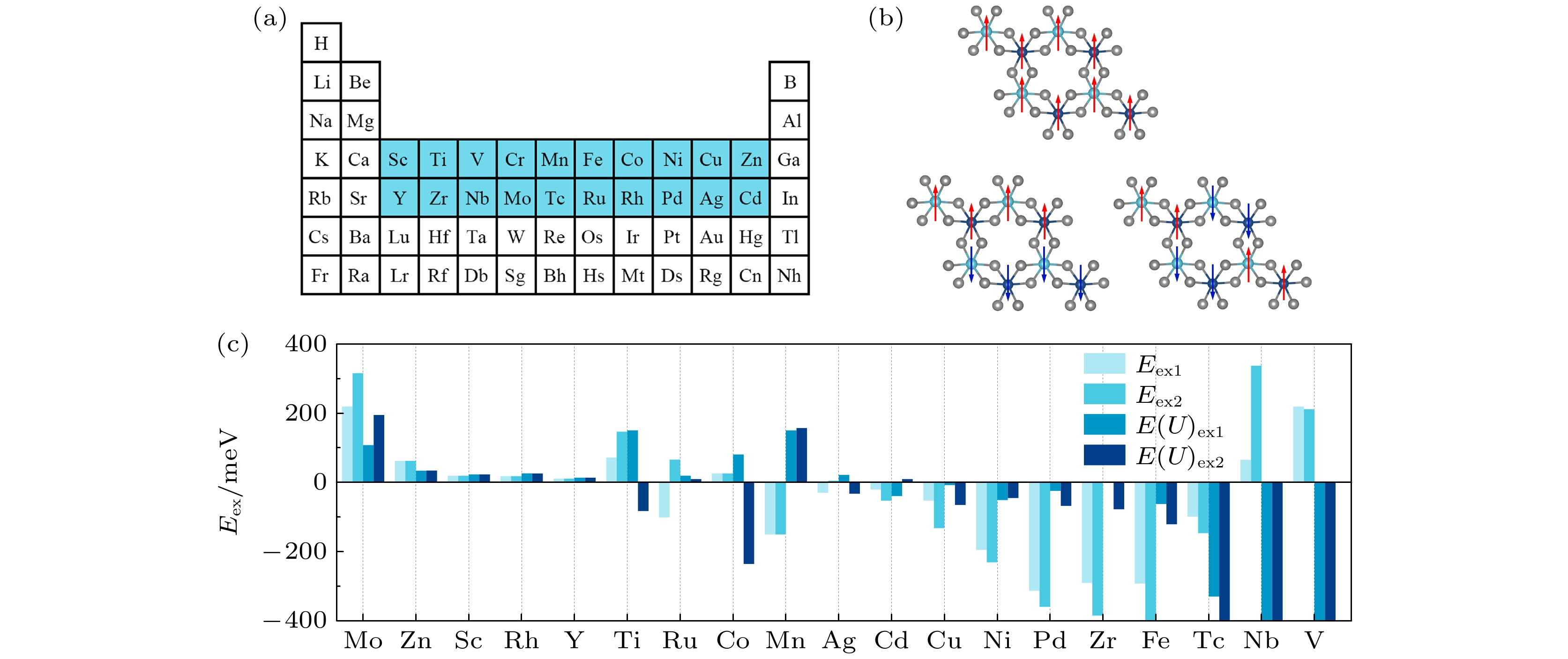
 下载:
下载:
